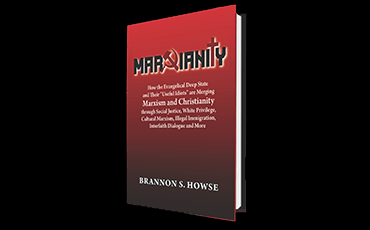Twisted Scripture Number 26: 1 Peter 3:18-20 Does NOT Teach Jesus Spent 3 Days in Hell After The Cross
By Brannon Howse
The Scripture: For Christ also suffered once for sins, the just for the unjust, that He might bring us to God, being put to death in the flesh but made alive by the Spirit, by whom also He went and preached to the spirits in prison, who formerly were disobedient, when once the Divine longsuffering waited in the days of Noah, while the ark was being prepared, in which a few, that is, eight souls, were saved through [the] water.
The Twist: Did Christ spend a few days in hell, burning off sins or preaching the Gospel to demons? Some within the Word of Faith Movement teach this heretical twist of 1 Peter 3:18-20.
To grasp the actual teaching in this passage, we need to understand that Jesus Christ died physically, but He never died spiritually. During the three days between His physical death and His resurrection, one thing He did, according to 1 Peter 3:19, is go to the place known as Sheol or Hades and announce His victory over death and the grave to the spirits there.
Jesus Christ was not there to preach the Gospel to demons. He was not spending time in hell to finish paying for sins—that was completed on the cross. From the cross, Christ cried out, “It is finished”—in other words, “Debt paid in full.” He didn’t have to do any more. He didn’t have to do time in hell, as many false teachers will tell you. He was in Sheol proclaiming His victory.
The Greek word used for “preach” in 1 Peter 3:19 is kerusso which is totally different than the word used in other places, where Scripture speaks of preaching the Gospel. We know He wasn’t preaching a Gospel message to the demons in Hades because the kerusso does not refer to evangelism; it references the announcing or proclaiming of something. Thayer and Smith Greek Lexicon explains that kerusso means:
to be herald; to officiate as a herald; to proclaim after the manner of a herald, always with the suggestion of formality, gravity, and an authority which must be listened to and obeyed; to publish, proclaim openly.
Christ was making a proclamation when He went into Sheol. He proclaimed to the spirits—some of them bound in eternal chains, others who are bound temporarily, some who were able to move in and out of that area—that He had won victory over death and the grave, over Satan and His evil spirits.
If Christ had been preaching the Gospel, the word in Greek would have been euangelizo which means to evangelize or to preach the Gospel. Luke 9:6 is an example of this word usage: “So they departed and went through the towns, preaching the gospel and healing everywhere.”
Colossians 2:14-15, on the other hand, offers a usage similar to 1 Peter 3:19. Here’s what we read:
having wiped out the handwriting of requirements that was against us, which was contrary to us. And He has taken it out of the way having nailed it to the cross. Having disarmed principalities and powers, He made a public spectacle of them, triumphing over them in it.
This is a picture of a contractual debt in which you would have a loan or mortgage written on paper, but it is wiped clear. And we see this same message in Ephesians 6:12:
For we do not wrestle against flesh and blood, but against principalities, against powers, against the rulers of the darkness of this age, against spiritual hosts of wickedness in the heavenly places.
Now, notice what else 1 Peter 3:20 says:
who formerly were disobedient, when once the Divine longsuffering waited in the days of Noah, while the ark was being prepared.
What is this about? This refers to demons who, according to Jude 6 and Genesis 6, during the time while Noah was building the ark, left their natural realm where they’re supposed to stay, and were disobedient. They began to engage in sexual relations with the daughters of men. Jude 6 points to this:
And the angels who did not keep their proper domain, but left their own abode, He has reserved in everlasting chains under darkness for the judgment of the great day.
That’s who Jesus was preaching to, demons who were and are bound in everlasting chains. Some of them are bound only for a period of time, and some are able to move around today. But eventually, they’re all going to be bound for good. Jude 7 goes on to reflect the demons’ treatment: “having given themselves over to sexual immorality and gone after strange flesh, are set forth as an example, suffering the vengeance of eternal fire.”
We see the source of this demonic abomination in Genesis 6. These are “the days of Noah” Peter is talking about. While Noah was building the ark, here’s what was going on (Genesis 6:1-4):
Now it came to pass, when men began to multiply on the face of the earth, and daughters were born to them, that the sons of God saw the daughters of men, that they were beautiful; and they took wives for themselves of all whom they chose. And the Lord said, “My Spirit shall not strive with man forever, for he is indeed flesh; yet his days shall be one hundred and twenty years.” There were giants on the earth in those days, and also afterward, when the sons of God came in to the daughters of men and they bore children to them. Those were the mighty men who were of old, men of renown.
The “sons of God” mentioned here are fallen angels. So in some way, fallen angels procreated with humans and created a hybrid offspring referred to in Genesis as Nephilim. The main physical trait we know of them is that they were giants. I believe part of what Satan was trying to do was to destroy the bloodline for the future Messiah. In Noah’s day, this hybrid and the extreme sinfulness of people were spreading havoc on the earth. God destroyed the whole earth except for eight people because of the sinfulness and also to wipe out the demonic bloodlines.
But you may ask, “Brannon, how is it that demons could have sexual relations with women?” That is a controversial topic, to be sure. Some believe these demons could literally take on the form of humans and engage in sexual relations with them. Others believe the demons had to take possession of the body of a man and then have relations with women. In other biblical contexts, we often see angels (not fallen angels) taking on the appearance or form of a man. So it is possible that the demons in Genesis 6 could do the same. Which one is it? I don’t really know, but the point is that the Bible tells us, one way or the other, it occurred.
Continuing with Genesis 6:5-8, we learn:
Then the Lord saw that the wickedness of man was great in the earth, and that every intent of the thoughts of his heart was only evil continually. And the Lord was sorry that He had made man on the earth, and He was grieved in His heart. So the Lord said, “I will destroy man whom I have created from the face of the earth, both man and beast, creeping thing and birds of the air, for I am sorry that I have made them.” But Noah found grace in the eyes of the Lord.
In his second letter, Peter brings this up again (2 Peter 2:4-5):
For if God did not spare the angels who sinned, but cast them down to hell and delivered them into chains of darkness, to be reserved for judgment; and did not spare the ancient world, but saved Noah, one of eight people, a preacher of righteousness, bringing in the flood on the world of the ungodly.
From this we understand that the sinful angels were sent to hell. These are the demons who had left their natural domain and procreated with the daughters of men. Because of that, they were cast down into chains of darkness, and, after the crucifixion, Jesus proclaimed to them His victory.
Studying this passage also brings us to an interesting question about demons: How many different kinds of demons are there? The Bible seems to teach that there are three. First, there are demons who are free to roam, for now. Another category of demons is those who are currently bound and will remain so until Revelation 9:1-12 when they’re released for a period of time. After that, they will be bound permanently as described in Revelation 20. Finally, there are the demons described in Jude 6 that are already bound in eternal chains. They will never be released, even for a period of time like those in Revelation 9.
So to review what is happening in 1 Peter 3:18-20: Jesus Christ is going down into Sheol and is proclaiming His victory to the demons imprisoned there. He is not preaching the Gospel and evangelizing the fallen angels. And He most certainly is not down there spending time paying for sins and getting born again. His work is forever finished on the cross.
Copyright 2014 ©Brannon Howse. This content is for Situation Room members and is not to be duplicated in any form or uploaded to other websites without the express written permission of Brannon Howse or his legally authorized representative.




